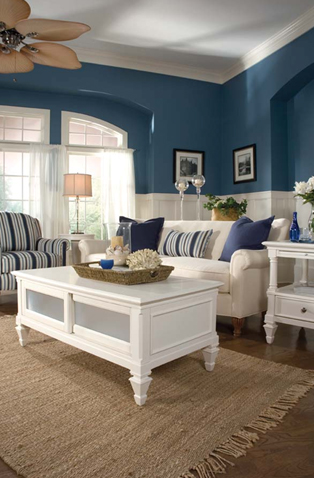 Color is the most important element in decorating, hands down, so knowing how to develop a color scheme that works throughout your home can seem pretty overwhelming. But don't make it more complicated than it needs to be - decide the colors you love, and go from there. Here are a few ideas of how to make your favorite colors work together.
Color is the most important element in decorating, hands down, so knowing how to develop a color scheme that works throughout your home can seem pretty overwhelming. But don't make it more complicated than it needs to be - decide the colors you love, and go from there. Here are a few ideas of how to make your favorite colors work together.
Getting Started
Find a fabric or object you really like - maybe a piece of artwork, a favorite quilt, or an Oriental rug. Use those colors to create the palette for walls, floor, furniture, and accessories. The book Color Solutions by Better Homes and Gardens suggests that you don't try to match the painting color for color, but rather use the inspiration piece as a starting point to select hues that would work well together throughout your house.
In each room, allow a different color to dominate and give each space its own personality. The repetition of the inspiration colors throughout your home knits rooms together and creates a feeling of comfortable cohesion.
How do you decide which colors to put where? Start with the rooms where you and your family spend the most time. What mood do you want to create? Which colors will help you achieve that mood? Use that color for the walls and perhaps a tint of a secondary color for the ceiling and floor. For furnishings and window treatments, look for fabrics that combine your inspiration-piece colors in varying amounts and shades. Solid-color fabrics will have the greatest impact and versatility, while prints or plaids add interest and variety.
Picking colors that work
The color wheel is one of the basic tools designers learn for decorating a home. Thousands of color combinations are possible, but you can use the color wheel's basic information to create the color scheme best suited for your home and your personal taste.
The color wheel generally shows the pure hues of colors: red, blue, and green. In decorating, however, you're more likely to be using tints (lighter values) and tones (also known as shades) that are darker values of a color. Keep in mind that colors that lie opposite each other on the wheel are complementary; when paired, each makes the other appear more vivid. Hues that lie beside each other are analogous; they always look good together because they share a common hue.
Different colors affect our moods in different ways, so consider the effect it will have on the appearance and mood of the room. For example, warm and cozy colors, located on the right side of our color wheel, tend to convey a message of togetherness and strength, while cool and soothing colors, located on the left side of our color wheel, provide a sense of calm and feelings of trust.
 Here are a few things to keep in mind about color psychology:
Here are a few things to keep in mind about color psychology: